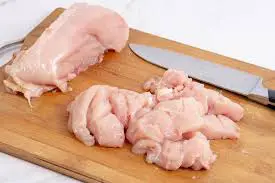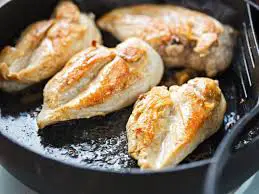What temperature is chicken done
What temp to cook chicken? This is one question which draws out different answers from different people. This is why I am going to write a detailed article post about it so that you can differentiate between fact and fiction about chicken cooking.
 To begin with, knowing the correct doneness temperature when cooking chicken guarantees juicy results, but what if the meat or juice is pink and there seems to be blood in it? If you’re like many others, the sight of anything other than completely opaque meat with clear juices can make you shiver when chicken is provided on the dinner table in that manner.
To begin with, knowing the correct doneness temperature when cooking chicken guarantees juicy results, but what if the meat or juice is pink and there seems to be blood in it? If you’re like many others, the sight of anything other than completely opaque meat with clear juices can make you shiver when chicken is provided on the dinner table in that manner.
Read on to find out what causes chicken to be pink and how you can make sure that the chicken your family members is eating is safe and not going to harm anyone.
FOOD SAFETY DEPENDS ON THE TEMPERATURE, NOT COLOR
Chicken has a creamy white color, unlike the stronger colors of beef, pork or lamb. This white color contrasts much more with the occasional pink tones that can be found naturally in any chicken meat.
Calculating chicken temp
When it comes to cooking chicken, there are many temperatures to consider. There is the temperature at which the oven is set and there is the actual temperature of the chicken itself (the so-called internal temperature), which can be measured with an instant-read thermometer. And then there’s also the minimum safe internal temperature in terms of food safety. In other words, the temperature your chicken must reach to make sure that any harmful bacteria it may harbor, such as salmonella or E. coli, get killed, is more important than anything else.
Lastly, you will have to keep in mind the temperature of the chicken for quality reasons – so that the breast meat remains firm and white, but not dry, and the dark meat remains smooth and soft as gum.
Doneness of white meat
 For quality reasons, a chicken breast is cooked correctly at 145 to 150 F. At this temperature any pinkness will disappear, but the meat will remain firm but still tender. However, according to the USDA, the chicken and poultry should be cooked to an internal temperature of at least 165 F for at least 30 seconds. The problem, however, is that when chicken breast meat is heated to 165 F, it becomes dry and tough and has a chalk like texture.
For quality reasons, a chicken breast is cooked correctly at 145 to 150 F. At this temperature any pinkness will disappear, but the meat will remain firm but still tender. However, according to the USDA, the chicken and poultry should be cooked to an internal temperature of at least 165 F for at least 30 seconds. The problem, however, is that when chicken breast meat is heated to 165 F, it becomes dry and tough and has a chalk like texture.
Fortunately, the USDA recommendation has two dimensions: temperature (165 F) and time (30 seconds). By expanding the time dimension, the target temperature can be reduced.
Doneness of dark meat
 Chicken thighs and all brown chicken meat should be cooked at a higher temperature – 175 to 180 F – because of their greater proportion of connective tissue. Cooking thigh meat at 165° F produces a gummy, soft meat, but at 175 to 180° F it is tender and juicy, while the collagen melts and turns into jelly.
Chicken thighs and all brown chicken meat should be cooked at a higher temperature – 175 to 180 F – because of their greater proportion of connective tissue. Cooking thigh meat at 165° F produces a gummy, soft meat, but at 175 to 180° F it is tender and juicy, while the collagen melts and turns into jelly.
CHICKEN IS MADE WHEN THE JUICE RUNS OUT
A common but erroneous method of checking the condition of chicken is to cut the meat and make sure that all the juices are clear. When we examine the chicken on the grill or in the oven, we often look for some pink patch in the meat. For one thing, we think that it is a clear indication that the meat is not yet properly cooked. The fact is that no matter wherever you test the chicken, the color of the meat or juices will never be free of pink, red or even purple hues.
So why does the chicken meat so often does not seem to be properly cooked?
WHY COOKED CHICKEN CAN STILL LOOK PINK
REASON No: 1: YOUNG CHICKENS ARE USED
The chicks available in the grocery stores that we buy are generally between 6 and 8 weeks old. These young chickens are not yet fully mature and their bones are more porous than being completely calcified. The bone marrow inside the chicken bones appears purple and can often penetrate through the soft, porous bones of the chicken.
The liquid in a chicken mass expands during freezing, as does the bone marrow. The black marrow can penetrate the bone surface as it expands. The bones and adjacent meat become blotchy and retain a deep red/purple color irrespective of the final internal temperature of the cooked chicken.
REASON 2: MYOGLOBIN
Myoglobin is another cause of the violet and red color of poultry. It is an abundantly pigmented protein that transports oxygen from the cells to the muscle fibers. The more active an animal is, the more oxygen it contains in its muscles, which gives its darkish color.
Chickens are birds that cannot fly, so breast meat is never highly oxygenated. Low myoglobin levels are the reason why chicken breasts have such tender white meat. Heavily stressed legs have darker meat due to high myoglobin levels.
Since chicken is packaged and prepared for purchase in a grocery store, myoglobin can accumulate in the fibers of the meat.
REASON 3: HIGH PH VALUES
The acidity of the meat can also influence its color. The higher the pH value, the pinker the meat is. Therefore some cooks use an acidic marinade with citrus fruits or vinegar to reduce the pink color of chicken meat. But marinades do not offer much protection against the pink tones of marrow and myoglobin.
EAT PINK CHICKEN WITH CONFIDENCE
Now that you know why your chicken can sometimes acquire a pinkish hue, it is time to eat chicken with more confidence. And most importantly, you should stop cooking the chicken too much!
With an accurate thermometer like the Thermapen, you can check the safety and quality of your chicken irrespective of its color. A probe inserted into the thermal center of a chicken breast or thigh, should read 165 degree Fahrenheit during the meal.
So, if you are still not sure at what temperature your chicken should be kept so that it can be eaten without making it dry and overcooked, you should pay heed to this. The short answer is that for a juicy and well cooked chicken should be kept at 150 F for at least 3 minutes for white meat and 175 F for dark meat.
Roasting a perfect chicken
The following steps in roasting a whole chicken produce a dark and white meat, tender, juicy and well cooked.
Preheat the oven to 500 F.
Place the chicken in a pan with a grill. Season with kosher salt.
Insert a digital probe thermometer into the deepest part of the breast and adjust it to alert you when the temperature reaches 145 F.
Place chicken in oven and immediately lower temperature to 350 F.
Wait about 90 minutes for the thermometer alarm to sound.
Remove the chicken from the oven and let it rest for 30 minutes, leaving the probe on the breast.
After 30 minutes, cut and serve.
Allowing the cooked chicken to rest
During the rest period, you can see how the temperature on the digital sensor display continues to rise and then falls again. When the temperature rise finally stops and it drops to 120 F, you are ready to carve.
Because the temperature of a roast chicken continues to rise for several minutes after it is removed from the oven, if you remove it to 145 F and let it sit for 30 minutes, the meat on the breast will stay above 145 F for longer than the required 8.5 minutes, making it tender, juicy and completely safe. The same goes for the dark meat, which eventually reaches a maximum of about 200 F. This is more than enough to break down the collagen in the meat, resulting in a dark meat that is tender, juicy and tasty.
Remember that the above times and temperatures only apply to the cooking of a whole chicken. It is the total mass of the whole chicken that allows it to maintain these temperatures during the resting period. If you tried to fry a single chicken breast, it would not work the same way.
Sous Vide Chicken Breast
There is a technique that is very suitable for cooking individual pieces of chicken at a certain temperature and keeping them at that temperature. This is called sous vide cooking.
With this cooking method, it is very easy to heat the chicken breast to 145 F for as long as you intend to. The added advantage of this kind of cooking is that no matter how long you leave your chicken breast in a water bath, it will never be more than 145 F (or whatever temperature you set according to your needs). This allows you to obtain a juicy and tender breast meat with a minimum effort.
Wrapping up
What temp to cook chicken
Hopefully, you would now have enough knowledge about what temp to cook chicken so that next time anyone asks you about this, you will be able to answer with more confidence like a culinary expert. Choose the correct temp for cooking chicken and embark on a cooking journey with chicken.